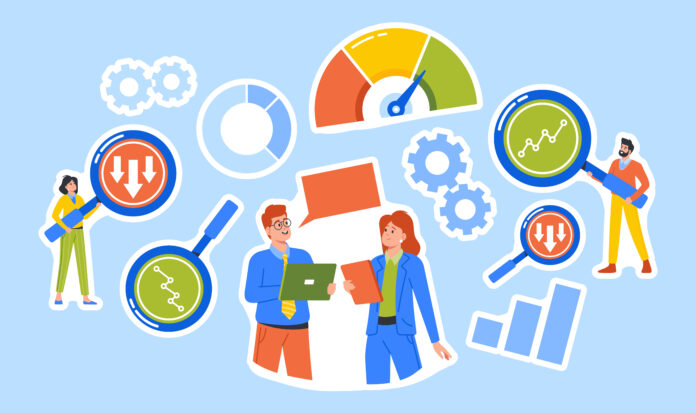As a business owner, you know that every decision carries risk. But what if you had a crystal ball that could show you potential pitfalls before they happen? Enter “Enterprise Risk Management (ERM) Software”. It’s your savvy risk advisor on speed dial, one that analyzes your data, alerts you to emerging threats, and even suggests smart moves. From supply chain snags to market curveballs, ERM keeps you one step ahead!
What is Enterprise Risk Management (ERM)?
Enterprise Risk Management (ERM) is a comprehensive, organization-wide approach to identifying, assessing, and managing risks that could impact a company’s strategic objectives, operations, compliance, and financial performance. It involves creating a risk-aware culture, establishing processes to prioritize risks, and developing strategies to mitigate or capitalize on those risks, all in alignment with the organization’s goals and risk appetite.
Key components of an ERM framework
The following components, based on frameworks like COSO or ISO 31000, create a holistic, organization-wide approach to managing risks.
- Risk Identification: Systematically identifying internal and external risks that could affect the organization’s objectives.
- Risk Assessment: Evaluating identified risks based on their likelihood and potential impact, often using qualitative or quantitative methods.
- Risk Response: Deciding how to handle risks—accept, avoid, mitigate, or transfer—based on the organization’s risk appetite.
- Control Activities: Implementing policies and procedures to ensure risk responses are carried out effectively.
- Information and Communication: Ensuring timely, relevant information flows throughout the organization to support risk management.
- Monitoring: Continuously evaluating the ERM process and individual risks to ensure the framework remains effective.
- Governance and Culture: Establishing clear roles, responsibilities, and a risk-aware culture from the board level down.
- Strategy and Objective-Setting: Aligning risk management with the organization’s mission, vision, and strategic objectives.
ERM vs. Traditional Risk Management
| Aspect | Enterprise Risk Management (ERM) | Traditional Risk Management |
| Scope | Organization-wide | Departmental or siloed |
| Approach | Holistic and integrated | Fragmented and isolated |
| Risk Types | Includes strategic, operational, financial, etc. | Typically focuses on insurable risks |
| Decision-Making | Informed by comprehensive risk analysis | Limited to specific areas |
| Responsibility | Shared across the organization | Handled by individual departments |
| Objective | Aligns risk management with strategic goals | Focuses on minimizing losses |
| Reporting | Continuous and integrated into overall governance | Periodic and department-specific |
What is ERM Software?
ERM software is a specialized digital tool designed to help organizations implement and manage their enterprise risk management processes effectively. It provides a centralized platform for identifying, assessing, monitoring, and reporting risks across all areas of a business, including strategic, operational, financial, and compliance risks.
ERM software automates and streamlines risk management, enabling companies to make informed decisions, respond swiftly to threats, and align risk strategies with business goals. It’s essential for turning risk management into a competitive advantage.
Key features of ERM software:
- Risk Register and Dashboard: Centralized repository for real-time visibility into risks and mitigation actions.
- Integrated Risk Assessment: Comprehensive risk assessments across categories and units with customizable scoring systems.
- Controls and Mitigation Tracking: Define and monitor controls and strategies with task assignments and reminders.
- Incident and Issue Management: Track occurrences and issues with incident reporting, investigation, and corrective actions.
- Workflow Automation: Streamline operations with alerts, task assignments, approvals, and document control.
- Risk Reporting and Analytics: Advanced reporting, visual dashboards, and predictive analytics.
- Ease of Use: User-friendly interfaces for easy adoption and simplified processes.
- Scalability: Grows with the organization, accommodating more users and information.
- Versatility: Supports compliance, continuity, audit, incident, and safety analytics.
- Security: Ensures data confidentiality, integrity, and availability.
Types of ERM software
There are various types of Enterprise Risk Management (ERM) software, each with distinct features:
- Risk Assessment Tools: Identify and prioritize risks using risk registers, heat maps, and scoring.
- Risk Monitoring and Reporting: Track risk levels and key indicators in real-time for informed decision-making.
- Compliance Management: Manage compliance with regulations through policy and audit management.
- Incident Management: Track, investigate, and respond to incidents affecting risk profiles.
- Integrated Risk Management: Combine risk management with governance, compliance, and performance for a holistic view.
- Cloud-based ERM: Scalable and flexible, reducing IT costs while offering comprehensive risk management features.
The best ERM software depends on an organization’s specific needs, industry, and risk management maturity.
How ERM Software Enhances Decision Making?
Enterprise Risk Management (ERM) software plays a crucial role in enhancing decision making by providing a comprehensive framework for identifying, assessing, and managing risks across an organization. Here are some key ways ERM software enhances decision making:
- Improved Risk Awareness: ERM software helps organizations identify and assess risks more effectively, enabling better risk management and more informed decision making. This includes identifying both internal and external risks, as well as their potential impact on the organization.
- Standardized Reporting: ERM software provides standardized reports that track enterprise risks, enabling leaders to make better-informed decisions about risk mitigation and resource allocation. These reports help identify key risk indicators, mitigation strategies, and emerging risks, providing a more comprehensive view of the organization’s risk landscape.
- Risk-Based Decision Making: ERM software helps organizations prioritize risks based on their likelihood and potential impact. This enables leaders to focus on the most critical risks and allocate resources effectively to mitigate them, leading to more informed decision making.
- Enhanced Collaboration: ERM software fosters collaboration across different levels of the organization, ensuring that all stakeholders are aware of the risks and involved in the risk management process. This leads to more informed decision making and a culture of openness and transparency.
- Real-Time Insights: ERM software provides real-time insights into risk levels and key risk indicators, enabling organizations to respond promptly to emerging risks and make adjustments to their risk management strategies as needed.
- Risk Monitoring and Reporting: ERM software enables organizations to monitor and report on risk levels continuously, providing a more comprehensive view of the organization’s risk profile and enabling better decision making.
By integrating ERM software into their risk management processes, organizations can make more informed decisions, reduce the impact of adverse events, and improve their overall performance.
Top 10 ERM Software Solutions in the Market
Explore the top 10 solutions to see how they can empower smarter decisions and propel your business forward.
-
Sprinto
- Sprinto offers a centralized view of all your failing, passing, and lacking controls and the security risks associated with it.
- Key Features: Role-based access management, evidence collection, risk overview, evaluation, categorization, prioritization, customizable workflows
- Pros: AI-based recommendations, assign owners to controls, manage risks effectively
- Cons: Pricing not publicly available
-
MetricStream
- MetricStream provides a comprehensive platform for managing risk, compliance, and governance.
- Key Features: Risk assessments, control testing, audit management, policy management, vendor risk management
- Pros: Scalable, customizable, integrates with other systems
- Cons: Steep learning curve, complex implementation
-
Diligent
- Diligent offers a suite of governance, risk, and compliance (GRC) solutions for organizations.
- Key Features: Board management, entity management, compliance management, risk management
- Pros: Intuitive interface, mobile accessibility, strong security features
- Cons: Limited customization options, expensive for small businesses
-
LogicGate
- LogicGate provides a no-code platform for building and automating risk and compliance processes.
- Key Features: Risk assessments, control management, policy management, incident management
- Pros: Easy to use, fast implementation, good customer support
- Cons: Limited reporting capabilities, can be expensive for large enterprises
-
RSA Archer
- RSA Archer is a leading GRC platform that helps organizations manage risk and compliance.
- Key Features: Risk assessments, control testing, policy management, vendor risk management
- Pros: Comprehensive features, integrates with other RSA products
- Cons: Expensive, complex implementation
-
Galvanize (formerly ACL and Rsam)
- Galvanize offers a suite of GRC solutions for organizations of all sizes.
- Key Features: Audit management, risk assessments, control testing, policy management
- Pros: Flexible deployment options, good customer support
- Cons: Limited reporting capabilities, can be complex for small businesses
-
Lockpath
- Lockpath provides a platform for managing risk, compliance, and third-party risk.
- Key Features: Risk assessments, control testing, policy management, vendor risk management
- Pros: Customizable dashboards, good reporting capabilities
- Cons: Limited integration options, can be expensive for small businesses
-
Riskonnect
- Riskonnect offers a suite of GRC solutions for organizations across various industries.
- Key Features: Risk assessments, control testing, incident management, claims management
- Pros: Industry-specific solutions, good customer support
- Cons: Limited customization options, can be complex for small businesses
-
Resolver
- Resolver provides a platform for managing risk, compliance, and security.
- Key Features: Risk assessments, control testing, incident management, business continuity planning
- Pros: Intuitive interface, good reporting capabilities
- Cons: Limited integration options, can be expensive for small businesses
-
SAI360
- SAI360 offers a comprehensive platform for managing risk, compliance, and ethics.
- Key Features: Risk assessments, control testing, policy management, training management
- Pros: Scalable, customizable, good customer support
- Cons: Complex implementation, can be expensive for small businesses
When choosing an ERM software solution, consider factors such as your organization’s size, industry, budget, and specific needs. It’s also important to evaluate the vendor’s reputation, customer support, and future roadmap to ensure a successful long-term partnership.

Implementing ERM Software: Best Practices
Feeling overwhelmed by the idea of implementing Enterprise Risk Management (ERM) software? Don’t worry, we’ve got you covered! Here’s a breakdown of key steps to ensure a smooth and successful journey:
- Know Your Why: Before diving in, define your goals. What risks are you most concerned about? How can ERM software help you achieve your objectives? A clear vision paves the road for success.
- Pick Your Partner: Not all ERM software is created equal. Research and choose a solution that aligns with your company size, budget, and specific needs. Don’t hesitate to ask for demos and trials!
- Get Everyone Onboard: ERM software is most effective when everyone’s involved. Communicate the benefits to employees across departments and encourage their participation. Training is key for user adoption.
- Clean Data is King: Garbage in, garbage out! Ensure the data you feed into the system is accurate and up-to-date. This will generate reliable risk assessments and insights.
- Start Small, Scale Smart: Don’t try to tackle everything at once. Begin with a focused implementation on a particular risk area, then gradually expand as you gain comfort.
- Monitor and Adapt: The risk landscape is constantly evolving. Regularly review your risk assessments and be prepared to adjust your strategies based on new information and emerging threats.
- Embrace Continuous Improvement: ERM software is a powerful tool, but it’s not a magic fix. Continuously evaluate your processes and identify areas for improvement to maximize the software’s effectiveness.
How StaQ CoPilot Finds the Perfect ERM Software for Your Business
Finding the ideal Enterprise Risk Management (ERM) software can feel like searching for a needle in a haystack. There are countless options, each with its own strengths and weaknesses. But worry not! StaQ CoPilot can be your secret weapon in this battle against risk management overwhelm.
Here’s how StaQ Copilot streamlines the process:
- Expert Insights: StaQ Copilot leverages the knowledge of industry professionals to curate a shortlist of ERM solutions that cater specifically to your business needs. No more wading through endless lists of generic software.
- Tailored Recommendations: StaQ Copilot doesn’t take a one-size-fits-all approach. By answering a few key questions about your company size, budget, and risk profile, StaQ Copilot tailors its recommendations to perfectly match your unique situation.
- Clear Feature Comparisons: Tired of deciphering confusing software jargon? StaQ Copilot presents clear side-by-side comparisons of key features offered by different ERM solutions. This makes it easy to see which software offers the functionalities you need most.
- Time-Saving Efficiency: By eliminating the need for extensive research and comparison, StaQ Copilot saves you valuable time and resources. You can focus on running your business while StaQ Copilot does the software selection heavy lifting.
Let StaQ Copilot guide you toward a future of confident risk management and a more resilient business.






